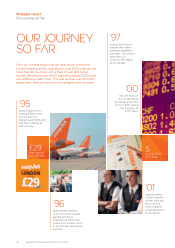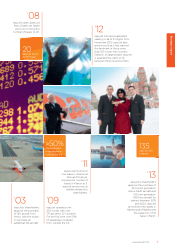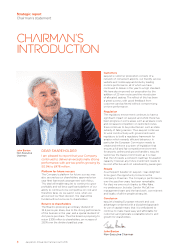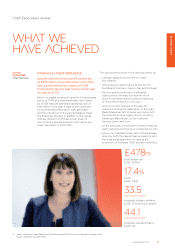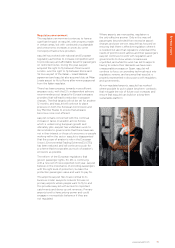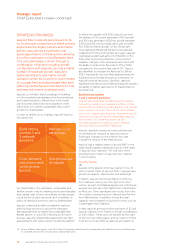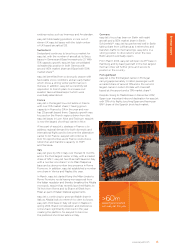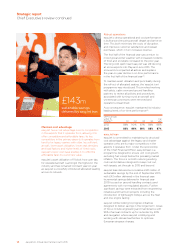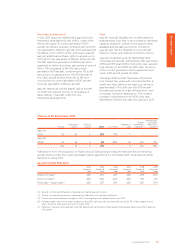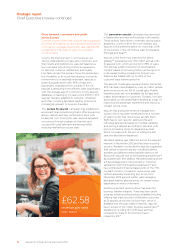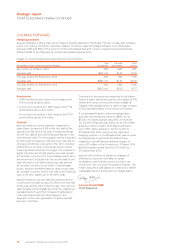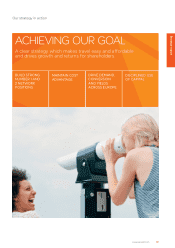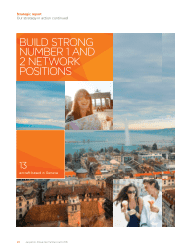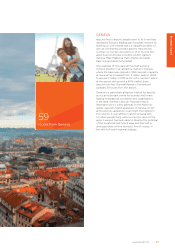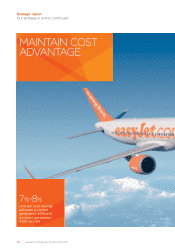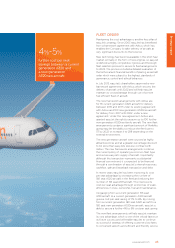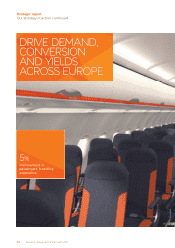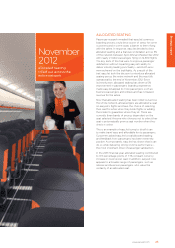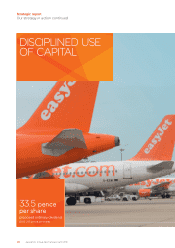EasyJet 2013 Annual Report Download - page 18
Download and view the complete annual report
Please find page 18 of the 2013 EasyJet annual report below. You can navigate through the pages in the report by either clicking on the pages listed below, or by using the keyword search tool below to find specific information within the annual report.
16 easyJet plc Annual report and accounts 2013
Strategic report
Chief Executive’s review continued
Drive demand, conversion and yields
across Europe
Over the course of the year, easyJet has progressed
a number of initiatives to drive demand and improve
unit revenue. Average revenue per seat was £62.58,
increasing by 7.1% year-on-year on a constant
currencybasis.
Core to the improvement in unit revenues is a
strong understanding of easyJet’s customers and
their needs and preferences. easyJet balances a
low cost base with strong customer experience
to optimise customer satisfaction and loyalty.
Low fares remain the primary focus for passengers,
but the ability to fly to primary airports in a family
environment is increasingly important. easyJet is
a pan-European airline with 56% of easyJet’s
passengers originating from outside of the UK.
easyJet is attracting more affluent older passengers,
with the average age of customers on the easyJet
database increasing by 1.2 years since 2009 to 41.5.
easyJet has also adapted its network, schedules
and offer, including allocated seating to become
increasingly relevant to business travellers.
The ‘europe by easyJet’ campaign has established
a resonant brand positioning that is effective across
all key markets and has continued to drive visits
to easyJet.com. During the year, easyJet targeted
consumers through a range of channels and
successfully used television advertising whilst
reducing marketing cost per seat.
The ‘generation easyJet’ campaign was launched
in September and was well received in all markets.
These actions have driven universally strong brand
awareness scores in all of the core markets and
easyJet is the preferred airline for more than 20%
of consumers in the UK, France, Italy, Switzerland,
Portugal and Spain(8).
easyJet is the third most searched for airline
globally(9) generating over 370 million annual visits
to easyJet.com, which accounts for 85% of sales.
The site has a high proportion of personalised
content based on browsing history and a rigorous
multi-variant testing programme ensures new
features are trialled with up to 20% of the
customer base before going live.
The easyJet mobile app was launched in December
2011, has been downloaded by over six million people
and now accounts for 5% of overall sales. Mobile
boarding cards are now available via the app and
makes travel easier for customers. Similarly, we have
automated our disrupted flight handling as a way of
improving the passenger experience and reducing
contact centre costs.
easyJet has a bespoke revenue management
system which has been developed over a number
of years to optimise revenue per aircraft. Each
flight has its own specific selling profile and
individual fare bands based on multiple variables
and pricing is altered according to demand, with
pricing increasing closer to departure as load
factors increase with the aim of selling the last
seat the day before departure.
Allocated seating was rolled out across the easyJet
network in November 2012 and has been a strong
success. Research conducted by easyJet suggested
that certain customer groups including business
travellers and affluent retired people were put off
flying with easyJet due to the boarding experience(9)
associated with free seating. Allocated seating drove
a 5 percentage point improvement in customer
satisfaction with the boarding experience(9) and
has contributed 0.9 percentage points of the 7.1%
constant currency increase in revenue per seat
without adversely impacting turn times. From
November 2013 easyJet will be yield managing
allocated seating, altering prices on certain routes
depending on levels of demand.
Another important revenue driver has been the
business traveller initiative. There has been good
progress enhancing the products available including
offering fast track security for flexi-fare customers
at 26 airports and a new inclusive fare, which is
available only through indirect channels. easyJet
has in excess of ten million business passengers(10)
travelling on a rolling 12 month basis and has
increased its share of the business travel
market by4%(11).
£62.58
revenue per seat
(2012: £58.51)


